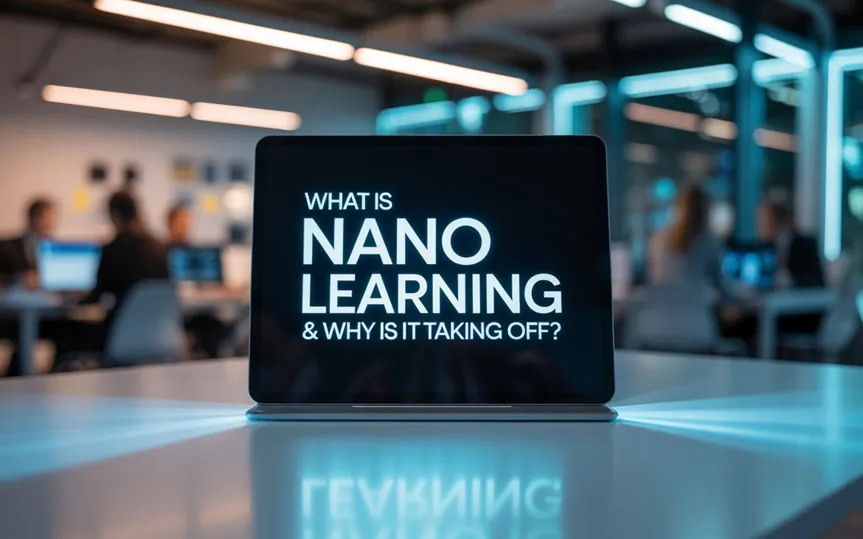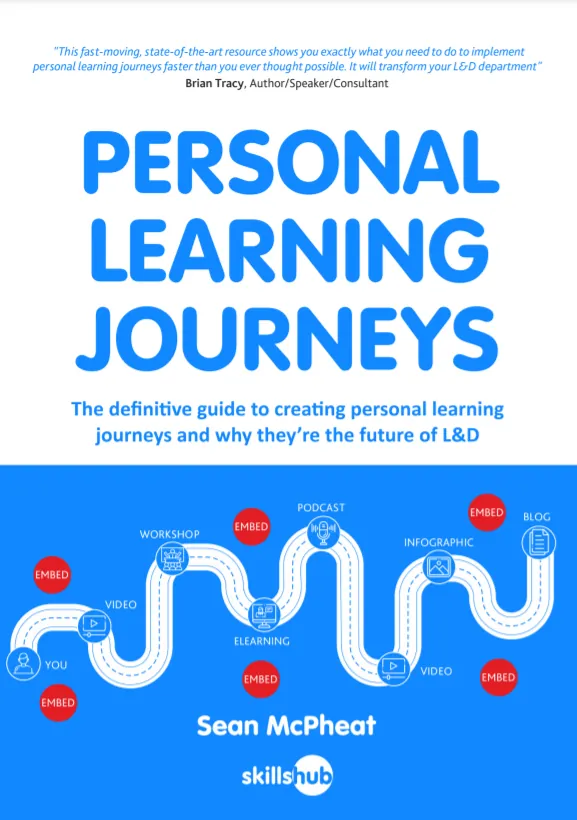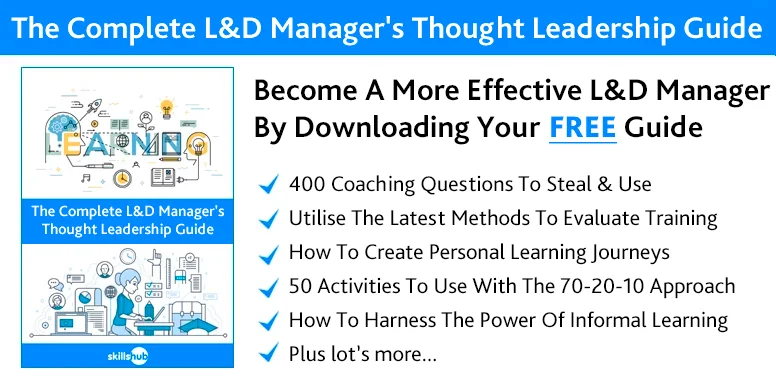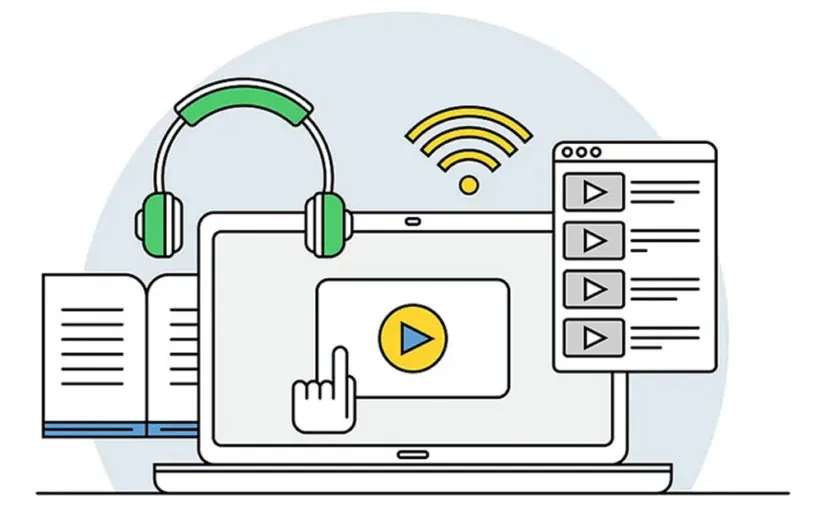
Nano learning is quickly becoming one of the most talked-about approaches in digital training, and for good reason.
As attention spans shrink and time becomes even more limited, learners are turning to bite-sized content that delivers quick, focused value.
For eLearning providers, this shift isn’t just a trend, it’s a signal to rethink how training is designed and delivered. In this blog, we’ll explore what nano learning actually means, how it differs from microlearning, and why it’s gaining traction in modern workplaces looking for speed, relevance and real results.

Defining Nano Learning
Nano learning is truly small bits of learning consumed in a single experience. That’s about 5 minutes at a time.
The term “nano” refers to a unit prefix within the metric system. It equates to just one billionth of a unit. Often used in electronics or science applications, it’s a very small measurement.
In nano learning, the goal is to learn a very specific detail. That doesn’t mean it’s not valuable content, though. In fact, it’s incredibly detailed and on target.
What Makes It Different from Microlearning?
Microlearning vs nano learning are two different types of learning applying the same concept. In microlearning, you’re getting a bit more. It’s still digestible, small amounts of learning. The difference? It takes no more than 15 minutes to consume. Microlearning gets you out of those hour-long lectures, but still provides rather robust content.
Nano learning is even more targeted. Here, the learning process is about 5 minutes. The difference is more than just time. This short-form learning focuses on a self-contained or single-object module. The more targeted it is, the more effective it can be at teaching an important, short lesson.

Learn How To Create Personal Learning Journeys For FREE!
Key Features of Nano Learning
As one of the fastest-growing digital learning trends, nano learning is a topic your team needs you to learn. It provides an effective way to offer employee learning on the go. There are several key features of nano learning that make it targeted and highly effective:
- It’s short. The content aims to deliver a lesson within 3 to 5 minutes. This short burst is perfect for your brain’s natural ability to capture content using short-term memory.
- Smaller deliverables. To be effective, nano learning focuses on small tasks and goals. It’s not about learning everything on a topic in one sitting. Instead, it’s broken into modules. Nano learners build knowledge over time. Each module builds on the last. This supports better learning retention of intricate details. It also means your employees can transfer that knowledge to the workspace more readily.
- It’s illustrative. The rapid learning technique creates content that’s actionable. It describes “how it is done.” Over time, your employees learn “why it is done” too. However, with highly specific examples, your team learns more effectively.
- Objectives are set. There’s a plan in place here. Your learner will move through smaller tasks to reach a goal. You’ll monitor that over time. This creates a very measurable, clear objective. You always know where your learners are in the learning process.
- Each module is complete. While modules build on each other’s value over time, every nano learning session is a complete lesson. Each module produces a specific outcome for the learner.
It’s quite direct and effective. You may wish your educators throughout your life had broken concepts down like this. That’s because these rapid learning techniques don’t have students with their heads in books memorising. It’s illustrative enough that it’s enjoyable learning. That applies even when the content itself is dry (and, let’s face it, boring!)
Consider some nano learning examples. Imagine launching an educational program, a short-form learning module, that provides employees with valuable information in bite-sized bits. Consider these practical workplace learning strategies:
- Compliance topic of the day. In a short 30 second to 1 minute email or video, share an important compliance topic and detail with your team to review. This could be an ongoing lesson spaced over a period of time.
- An infographic breaking down the onboarding process. A graphic could act like a checklist, providing the steps a team member needs to take to onboard an employee effectively.
- New software education. A short 2-minute instructional video shares with your employees how to get the most out of a specific type of feature. It may create a step-by-step description of when and how to apply that software to their daily work tasks.
- Interactive quizzes. After reviewing a topic during a previous lesson, the next learning module offers a quick, interactive quiz that reinforces its value.
- A descriptor video. Break down a specific industry trend or new job-specific task in a descriptor video that outlines the specific applications of that video to your employee’s job.
- Just-in-time lesson. If your business is launching a new strategy, a just-in-time module provides everything they need to know in an interactive or engaging 5-minute video.
No matter which of these strategies is applicable and usable, or if others are, the content provided is always very specific. It provides excellent insight and valuable information in short form. It does so in a way that’s helpful to your employee – not just anyone.
Why It’s Designed for Today’s Learners
Data from numerous studies shows that employees value learning. It contributes to better staff retention and satisfaction with their job. Yet time matters, and attention spans are limited. Nano learning lets busy people learn on the go. It’s rapid skill development that employees can complete at their own pace.
The leaner captures valuable, applicable information. They retain it better. And, most importantly, they keep learning because it’s not challenging to expand their knowledge base.

Why is Nano Learning Gaining Popularity?
Nano learning is one of the modern training methods employees and employers can both be excited about putting into place. It’s gaining popularity across all sectors and industries because of how effective it is.
It’s essential to know that this rapid learning method is not about inferior data or limited content. Students learn highly valuable details and applications related to their job and specific task needs. It’s a transformation of how deep, valuable content is shared and absorbed by your employees.
For today’s students, no matter the concept, nano learning is gaining popularity because it works, it’s less stressful, and it’s easier to incorporate into everyday work schedules.
Consider that Gen Z and Millennials are learners. They want to learn. But, traditional length programmes are not applicable to everyday life. These aged learners enjoy smaller bite-sized learning methods.
Why is that? Let’s explore some of the most important reasons why nano learning is so critical to the future of employee learning.
Short Attention Spans and Busy Schedules
Attention spans are shorter. We all know this. Short-form videos have taken the place of sitting down for a 30-minute television show. Why? Attention spans have changed with the growth of the digital world. Time Magazine published a detailed article outlining why this is, but it comes down to two factors:
- Modern stressors are everywhere. Our brains can only handle stressors in short bursts before moving on to the next.
- Constant use of technology makes it far harder to focus on a single topic. There are so many topics at hand. This has reprogrammed the way our brains capture and navigate information.
Ever notice when scrolling a great content channel or news story that there’s now a “5-minute read” or “7-minute read” notation under the heading? People do not have time. And that lack of time does not mean they don’t want information. They just need that information in a smaller package.
The same is applicable within the work environment. Your employees want information. They know it helps you and helps them. But how many people in your office can dedicate a week to a seminar or even an hour to an educational meeting with the team? Time is more valuable than ever. Nano learning offers quality information in a more manageable module.
That’s not a bad thing. The fact is, it’s an effective way of learning today, thanks to the massive changes to brain functionality and retention of content. With so many stimuli, nano learning fills in those gaps just enough to capture valuable content.
Mobile-First, On-the-Go Learning
The application of providing that information matters, too. When we look at younger in-office workers, consider the tools they like to use. Do you ever see a Gen Z employee without their mobile device? Not likely. It’s simply become the way of the world.
Some data indicates that 60 out of 100 people today prefer to learn, engage, and interact with information using a smaller screen. Think smartphones and tablet devices. They always have that device on hand, which means learning can happen anywhere. There’s no need for a dedicated classroom in the office. You can skip having to send your team off to a local educational seminar or specialised classroom session. They can learn here and now, no matter where that is.
With mobile-first learning, your employees need no additional software or text. They do not need time away from their office. They can sign in, complete a module between meetings, and take away valuable information instantly. There is no disruption to the day’s tasks.
The Rise of Just-in-Time Training
The concept of just-in-time may not have originated in the use of education. Rather, it refers to a manufacturing strategy in which materials needed for the project arrive just in time for the next phase. They are not sitting, piling up in the background, taking up space and commanding employee attention.
In the application of education, just-in-time training is a way to provide employees with the knowledge and data they need, but just when they need it. Rather than a long, drawn-out educational program for “down the road,” the concept provides information when the employee needs it and can use it immediately.
What we also know about nano training is that it delivers a way for adults to learn in an effective way. Way back in the 1980s, Malcolm Knowles, a noted educator, studied the process of teaching adults. Instead of classroom-based education taught at younger ages, he found that adult education must be:
- Self-directed learning
- Based on their previous experiences
- Focused on previous mistakes or opportunities
- Relevant to what the student is doing now
- Problem-centred and, most importantly, actionable, not just content-centred
That’s what just-in-time training offers. Likewise, nano learning makes it possible to learn in this manner. It’s quite fascinating to watch your adult learners take in information readily and want to do so. Then, they can apply that same concept to the projects they are working on with near-immediate benefits to your business model.

How eLearning Providers Are Using Nano Learning
For eLearning providers, the use of nano learning is versatile and quite flexible. It can be used in a variety of manners, including providing employee learning on the go in a very specialised environment.
The key to successfully using workplace learning strategies like this is to ensure they meet your learners’ specific needs. That means it’s all about value.
How can an eLearning provider offer this content to you? There are various strategies that may be applicable, though each need could be expanded in different directions.
Embedding It into Existing Platforms
One of the simplest methods is to embed these bits of learning into already-in-place educational models. This application allows nano content to be embedded into the workflows of your employees as they are already learning—think quizzes. For large-scale educational tracks, the inclusion of nano learning into existing content enables a more targeted focus on specific topics.
Embedding it into existing platforms could mean incorporating quizzes or feedback. It may also include real-time assessments of content already covered.
Creating Standalone Nano Modules
Standalone nano modules are applicable across most educational tracks. You may have a specific objective for your team. You want them to learn a very specific skill or dive into new technology. A standalone nano module makes that possible.
The content is created specifically for the application at hand. Short-form learning delivered your way! With standalone nano modules, it is possible to create a very custom solution, one that targets what you need your employees to learn.
With eLearning providers, it requires more hands-on understanding of what your employees need. You may be able to select from ready-to-do training or have it custom-designed. In either case, these modules aim to provide a complete topic focus applicable to your business’s needs.
Blending Nano with Broader Learning Journeys
Quite commonly, nano learning can be blended with other strategies. If your employees need to learn a hands-on skill, it may be necessary to blend quick learning modules alongside current educational plans that offer in-person education or training that’s more elaborate.
To achieve this, eLearning platforms integrate specific topic knowledge—those short bursts of information—into larger experiences. This approach could help enhance your team’s engagement when they are already taking in huge amounts of information. The nano training element gives them a way to break up that more intense learning process to make it more efficient and retainable.

Benefits of Nano Learning in the Workplace
Not all digital learning trends are worthy of investment. However, as you can see from the nano learning examples thus far, there are true benefits to incorporating this short-form learning into your workplace education.
Faster Engagement and Quicker Results
One of the best reasons to apply this form of rapid learning is that it’s engaging. Nano learning gets people to capture valuable information more effectively. Let’s be frank. Having an employee sit down to read a complex manual on how to meet compliance requirements or what steps they must take to complete a task is boring and hard to do. It takes no physical effort but significant brain focus and concentration.
In a world where people simply are not able to focus on a single topic for a long period of time, nano training delivers. It provides faster engagement with the content provided and also allows them to take that information and apply it directly to their workday. In this way, nano learning:
- Takes advantage of short attention spans
- Let employees capture valuable information they need
- Keeps employees from getting bored or tuning out
- Allows them to take what they have just absorbed and apply it immediately
- It ensures your team is consistently working to improve
- Nano learning helps make your investment in employee education more evident sooner
Also notable, it’s quite flexible in this way. You can create workplace learning strategies that fit your specific work needs. It can be applied based on your team’s current areas of focus. It may even deliver very specific information critical to this week’s project.
Supports Continuous Learning Culture
Using just-in-time training or nano learning is not solely for specific bits of information applicable to today’s tasks at hand. Rather, it fosters a way to continuously learn and capture information on an ongoing basis.
A continuous learning culture is a competitive advantage for most of today’s businesses. By providing frequent, small doses of knowledge to your team, they are constantly learning and growing. That means they are at the top of their game. Continuous learning itself offers several benefits to your employees and business:
- The cumulative effect of ongoing learning produces better productivity, efficiency, and business objective achievement
- Your team knows they are learning, and that’s valuable to them
- Employees are staying on top of ever-evolving knowledge in a fast-growing industry
- Your business remains competitive because you have the most up-to-date and well-trained team behind the operation
- Education and learning become a habit, not a dreaded task, and that benefits everyone
Note that mobile learning formats provide businesses with a way to adjust and modify what employees are learning over time. There’s not just a single strategy to achieve. It’s versatile enough to flex as your business’s needs change.
Reduces Cognitive Load and Increases Retention
If you are honest with yourself for a moment, you may remember struggling to stay away during a professor’s long, boring lecture. That’s not because you didn’t see value in the content. Rather, it’s because your brain wasn’t firing on all the neurons that it could have been. Nano learning changes the functionality of learning.
In doing so, it reduces cognitive load. That’s the balancing act your brain has to manage as it tries to capture valuable information and manage the dozens of other stimuli around. By reducing cognitive load and zeroing in on a very specific topic, the brain captures that information in short-term memory. It is instantly available and usable.
Second, nano learning reduces learning fatigue while increasing retention. That doesn’t seem possible. Yet, when we consider that instead of dumping hours of content at one time, and hoping that some of it sticks, we can apply small bits of information in a meaningful way. Then, we build on that. This ensures the brain remembers more of that content over time.

What the Future Holds for Nano Learning
While nano learning sounds like a win-win for everyone, it has limitations. Notably, not all nano learning is helpful enough to make it worth the investment. When applying these modern training methods, consider the following factors before going all-in.
When Nano Learning Isn’t Enough
There are times when nano learning just is not enough. It provides some information and a range of it. However, there are times when there’s a need for more depth and explanation of more detailed components of a topic. The challenge with applying nano learning is ensuring the quality is excellent and on target. You need to be sure your learners are spending time on content that’s beneficial.
In other words, for many more challenging learning needs, use nano learning as a complement, not a replacement. There’s still value in longer form and more elaborate training methods.
Avoiding Content That’s Too Surface-Level
This type of employee learning on the go must be valuable to be effective. If you only provide short segments on surface-level or thin content, that’s all your employees can take in and use. That may not be enough.
A common mistake, then, is to put nano learning on auto pilot. You may choose an educational track that seems good because it’s tackling valuable topics. Yet, if it is only skimming the top and not providing authentic, truly applicable, and meaningful data, it’s missing the market.
The most effective rapid learning techniques do not skimp on quality and depth. They build one lesson on the next, offering more information and more depth. If you do not choose the best application for this, it could mean your employees are not getting the depth of knowledge they need to remain competitive.
If you select the use of bite-sized learning, then choose a curriculum and learning path that’s both practical in its format and comprehensive in its content. That makes it worthwhile when applying it to your business model. Review the content provided yourself, ensure it is tackling the entire topic, but in smaller pieces at a time.
Balancing Depth with Speed
We often need our team to learn something fast. You learned that the competitor was providing their employees with a new skill. You want to roll out the same skill, and you want it done yesterday. It may be possible to implement nano learning quickly. However, you must balance speed with quality.
If your employees simply hit the “play button” and watch video after video just to rush through it and complete the learning module, they’re missing the point. And your business is missing the value that learning offers. Alternatively, you must ensure that employees are learning quality content at a sustainable level. They should be able to capture information and apply it to their workday. It is not just about getting it done. It is more so about making sure it sticks.
Conclusion
As a business, you value educating your employees. You want them to remain top of their game. That benefits them, and it benefits you. Yet, it’s critical to apply learning in a way that today’s employees can actually use and apply in a format that’s adapted to the way people learn.
By applying bespoke eLearning to your employee’s educational and training path, you provide them with a way to capture valuable information and resources they need to contribute to the betterment of your business.
With eLearning content so readily applicable to today’s employees, finding the right format and applying these strategies is easier to do than ever. It all comes down to choosing the best eLearning platform for your business that delivers quality information in a format that fits your team’s ability to learn.













